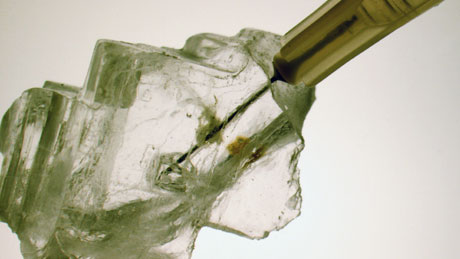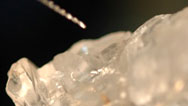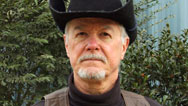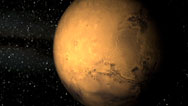
Secrets in the Salt
Salt deposits that formed 250 million years ago hold tantalizing hints of early life. Airing July 28, 2009 at 9 pm on PBS Aired July 28, 2009 on PBS

Program Description
Transcript
Secrets in the Salt
PBS Airdate: July 28, 2009
NEIL DeGRASSE TYSON: In ancient Egypt, they used salt to preserve their dead. It worked so well, bodies thousands of years old are still around today, looking pretty good, too. Well, now researchers are uncovering evidence that salt has preserved life forms much older than any pharaoh. Correspondent Ziya Tong explores a place where the ultimate natural preservative may enshroud remnants of life a quarter-billion years old.
ZIYA TONG: At a high-security government facility, in the middle of the New Mexico desert, a team of experts are getting ready for an expedition. Microbiologist Jack Griffith, biologist Bonnie Baxter and research analyst Smaranda Wilcox have agreed to take me with them to a place few people ever get a chance to see.
After gearing up, we're escorted to an old industrial elevator which will take us 2,000 feet below the surface of the earth.
There's no H for "Hell" button.
We're going on an underground hunt, in search of ancient life.
So how far deep do you think we are, in terms of time, as we're going down?
JACK GRIFFITH: It's about two million years per second.
ZIYA TONG: Two million years a second that we're heading down?
JACK GRIFFITH: Past the dinosaurs.
BONNIE K. BAXTER (Westminster College): There's a dinosaur.
JACK GRIFFITH: So in a way, this is a time machine, a very fast time machine.
ZIYA TONG: A time machine that descends through layer after layer of ancient rock.
Finally we stop, get out and find ourselves smack in the middle of a salt formation over a quarter of a billion years old.
Imagine Planet Earth, 253 million years B.C.: a world before the age of dinosaurs, even before flowering plants. True mammals hadn't evolved yet, but the insect population is thriving.
It was during this time period, known as the Permian, that the salt deposit was formed. It started out as an enormous salt lake in the middle of an intensely hot desert.
DENNIS POWERS (University of Mississippi): Two-hundred-fifty-million years ago, it would have been just absolutely miserable. The temperature might have been 140 degrees.
ZIYA TONG: All that heat caused the lake to dry up, leaving behind an enormous pile of salt, hundreds of miles wide. Over time, the salt got buried under a 1,500 foot layer of rock, where it remained isolated and protected from the catastrophic events that were about to change the face of Planet Earth forever.
The Permian world ended with the most devastating extinction event of all time. Most forms of life died off, and scientists still aren't sure why. But, down here, the team believes, remnants of this mysterious time period had a chance to survive, buried in crystals of salt, an idea originally inspired by Bonnie's work. For over a decade she's studied how salt crystals form in salt lakes.
BONNIE BAXTER: In modern salt that we collect from the shores of Great Salt Lake, we find lots of microbes, bacteria and things like that, that live inside the salt crystals.
ZIYA TONG: That's because, as salt crystals form, microscopic pockets of water often get trapped inside, and with it, salt-loving microbes. That got Bonnie thinking, "Could ancient microbes from the Permian have survived the same way?"
JACK GRIFFITH: It opens up a door to this world that existed a quarter of a billion years ago.
ZIYA TONG: A door that could fill in missing pieces of the evolution of life on the planet. But to do that, the team needed access to ancient salt.
It turns out, the U.S. government has plenty of it. Back in the 1990s the Department of Energy hollowed out miles and miles of tunnels right through this Permian salt formation.
What is the D.O.E. doing with miles of underground tunnels? They use it to store radioactive waste.
So this is, like, nuclear waste?
ROGER NELSON (United States Department of Energy): This is radioactive waste resulting from the production of atomic bombs. You're looking at the legacy of the Cold War between the U.S. and the Soviet Union.
ZIYA TONG: A legacy the D.O.E. believes is best kept deep below the surface of the earth.
But, for scientists, these underground tunnels serve a very different purpose, providing rare access to salt that's been buried under a protective layer of rock for hundreds of million of years.
So these walls are just pure salt?
JACK GRIFFITH: Pure salt. The reddish is some sulfur deposits, then the browner areas contain clays. So, what we're looking for are some of these little areas that are clear, because the clear area very likely contains possibly D.N.A., bacteria, we don't know.
ZIYA TONG: Right.
JACK GRIFFITH: Yeah. So, there's a piece.
ZIYA TONG: Wow.
JACK GRIFFITH: I'll have a piece too.
ZIYA TONG: It tastes...
JACK GRIFFITH: ...just like salt.
ZIYA TONG: Pretty much just like the modern stuff, huh?
JACK GRIFFITH: It does. It does. Probably in a French restaurant it would be very pricey.
ZIYA TONG: Yeah, I imagine so.
JACK GRIFFITH: Of course we don't know what's in it.
ZIYA TONG: I wonder what you could get for this on eBay.
Soon we were joined by geologist Dennis Powers. He's spent years studying this formation.
JACK GRIFFITH: What do you think, Dennis? Are we in a good area here?
DENNIS POWERS: Yeah, we'll just follow this line along here. You see the light shining into the crystals, and it starts to disperse out, and the whole wall lights up here, just like that. That would be the kind of place we want to sample, Jack.
ZIYA TONG: They mark a spot where the salt crystals are clear and drill several inches into the wall to remove them. What we were about to unearth literally hadn't seen the light of day for over a quarter of a billion years.
It looks like those rock sugar candies that I used to eat.
BONNIE BAXTER: It's so clear, look at that. You can see right through it.
ZIYA TONG: There's little bubbles in there, huh?
JACK GRIFFITH: Little bubbles, we'll have to see what they are.
ZIYA TONG: It takes a few minutes for us to get back to the surface, where I can finally get a better look at the mysterious tiny bubbles the team came here to find.
JACK GRIFFITH: Can you see the little bubble as we rotate the crystal?
ZIYA TONG: Yeah.
JACK GRIFFITH: That cavity and the others are full of liquid, and that liquid was trapped a quarter of a billion years ago, when the salt deposit was formed. So these are little microscopic time capsules.
And the hope was that, perhaps, these tiny liquid time capsules might contain biological molecules that were synthesized before the great Permian extinction, 250 million years ago.
ZIYA TONG: Ancient liquid, older than the dinosaurs, even older than flowering plants. But does it really contain remnants of ancient life inside? Back home in North Carolina, Jack is determined to find out. At the Griffith lab, that means devising a way to photograph what's inside these tiny time capsules with an electron microscope, a difficult and delicate process.
Jack is renowned for his extraordinary images of the smallest of things, like D.N.A. and protein.
BONNIE BAXTER: He is simply the best person in the world to photograph tiny molecules of life.
ZIYA TONG: Smaranda starts by sterilizing the salt crystals.
SMARANDA WILLCOX (University of North Carolina): We put the salt crystals in this very potent acid mix. The acid will eat away anything that's on the surface, and then I look at the crystal.
ZIYA TONG: Cracks mean modern contaminants have a chance of getting inside, so those crystals are discarded. Then they drill a tiny hole, the size of a cat's whisker, right into the tiny time capsule. Now it's time to remove the ancient liquid and discover whether any remnants of life have actually survived a quarter of a billion years.
JACK GRIFFITH: The sample was covered with these fibrous materials that you see here. A lot of it looks like some pasta...
ZIYA TONG: Right.
JACK GRIFFITH: ...that had been laid down in flat sheets. And we've never seen this before.
ZIYA TONG: Well, what are we looking at here?
JACK GRIFFITH: Well, we didn't know because we've been doing this for 30 years, this was new. So the question is what was it?
BONNIE BAXTER: We were absolutely flabbergasted.
SMARANDA WILLCOX: It was a stretch of imagination, really, to come up with what it could be.
ZIYA TONG: No one ever suspected that these pasta-like noodles were, in fact, ancient cellulose.
JACK GRIFFITH: We think D.N.A., we think proteins, we think about R.N.A., but we had never really thought about cellulose, and so this was quite a surprise.
ZIYA TONG: But maybe it shouldn't have been, when you realize that every year the planet produces a hundred gigatons of the stuff.
Cellulose is a long chain of sugar molecules; it's produced by some forms of bacteria who live on it. But this tough little molecule is best know as the main component of the cell walls of all green plants, from algae, to leaves, to grass and trees.
Cellulose has the honor of being the most common organic compound on Earth. Two-hundred-fifty-million years ago, the landscape was positively overflowing with it.
What you've captured here is the actual...
JACK GRIFFITH: Is the real...
ZIYA TONG: ...organic material.
JACK GRIFFITH: This is the real, actual organic molecules that are a quarter of a billion years old, so these are clearly the oldest direct evidence of life on the planet. Fossils go back into the billions of years, but you're still looking at rock casts.
ZIYA TONG: Right.
JACK GRIFFITH: You can't do any biological tests on fossils. That's what's really most exciting about this material, that, not only can you see it, but you can actually do things with it in the test tube.
As new modern methods get better and better, there could be secrets that we could discover in the nature of cellulose that could tell us about many features of this ancient world.
On Screen Text: So what exactly is the radioactive waste they store down here?
We got to see inside the canisters with U.S. Department of Energy X-ray images, and it's mostly just contaminated tools and stuff, dating back as far as the Manhattan Project. Like these.
Can you find them in the X-rays?
Broadcast Credits
Secrets in the Salt
- Edited by
- David Chmura
- Produced and Directed by
- Terri Randall and David Chmura
NOVA scienceNOW
- Executive Producer
- Samuel Fine
- Executive Editor
- Neil deGrasse Tyson
- Senior Series Producer
- Vincent Liota
- Senior Producer
- Julia Cort
- Supervising Producers
- Stephen Sweigart
Joey David Jovanovich - Senior Editor and Colorist
- David Chmura
- Online Editor
- Laura Raimondo
- Senior Researcher
- Sharon Kay
- Associate Producer
- Fran Laks
- Assistant Editors
- Tung-Jen (Sunny) Chiang
Aleksandar Nedeljkovic - Graphic Design
- Brian Edgerton
- Compositor & Animator
- Yunsik Noh
- Music
- Rob Morsberger
- Sound Mix
- Bill Cavanaugh, RazorMix, Inc.
- Assistant to Neil deGrasse Tyson
- Elizabeth Stachow
- NOVA scienceNOW Series Animation
- Edgeworx
- Associate Producers
- Melanie Cunningham
Sheraz Sadiq
Daniel Sites - Camera
-
Steve Baum
Mark Carroll
Joseph Friedman
Blake McHugh - Sound Recordists
- Mark Carroll
Charlie Macarone
Helen Silvani
David Renner - Animation
- Carlo Flores
David Margolies
Sputnik Animation
James LaPlante - For Lone Wolf Documentary Group
-
- Executive Producer
- Kirk Wolfinger
- Production Manager
- Donna Huttemann
- For Public Broadcasting for Northern California, KQED
-
- Executive Producer
- Sue Ellen McCann
- Business Manager
- Sandy Schonning
- Archival Material
- BBC
Beaucroft
Courtesy of DreamCatcher Interactive, Inc
ESA/Hubble
Free Stock Footage
Kenneth Garrett/National Geographic Image Collection
Knoxville Zoo
Bernd Lelle
Lawrence Livermore National Laboratory
Kevin Miles, FBI Large Vehicle Bomb School and Chris O'Leary, Video2Digital
Motiondrops Stock Footage
NASA
NASA/courtesy of nasaimages.org
NASA Ames Research Center
NASA Johnson Space Center
NASA/John Frassanito and Associates
Courtesy NASA/JPL-Caltech
NASA/JPL/USGS
NASA/Pat Rawlings (SAIC)
NASA/USGS-Flagstaff
National Geographic
Roger Nelson
Luc de Nil
Northrop Grumman, Advanced Concepts Technology & Emerging Systems Division
Polychromix
Asa Schultz
Peter Schultz
N.A. Sharp, NOAO/NSO/Kitt Peak FTS/AURA/NSF
Smithsonian Institution
Marc Weyerstall - Special Thanks
- Arizona State University
Alan Binder
Byrd Polar Research Center
Phil Christensen
Jonas Dino
Grey Hautaluoma
Dennis Kavlakoglu
Sally Koris
The Methodist Neurological Institute
Roger Nelson
New York Presbyterian Hospital, the University Hospital of Columbia and Cornell and Citigroup Biomedical Imaging Center
Tomomi Niizeki
Ian Ryan
Sahar Salem
Phil Schneider
Susan Scott
Francois Thibaut and The Language Workshop for Children
Waste Isolation Pilot Project - Neil deGrasse Tyson
- is director of the Hayden Planetarium in the Rose Center for Earth and Space at the American Museum of Natural History.
- NOVA Series Graphics
- yU + co.
- NOVA Theme Music
- Walter Werzowa
John Luker
Musikvergnuegen, Inc. - Additional NOVA Theme Music
- Ray Loring
Rob Morsberger - Post Production Online Editor
- Spencer Gentry
- Closed Captioning
- The Caption Center
- NOVA Administrator
- Mykim Dang
- Publicity
- Carole McFall
Eileen Campion
Victoria Louie
Karinna Sjo-Gaber
Karen Laverty - Marketing
- Steve Sears
- Researcher
- Kate Becker
- Senior Researcher
- Gaia Remerowski
- Production Coordinator
- Linda Callahan
- Paralegal
- Sarah Erlandson
- Talent Relations
- Scott Kardel, Esq.
Janice Flood - Legal Counsel
- Susan Rosen
- Production Assistant
- Ryan Murdock
- Post Production Assistant
- Darcy Forlenza
- Associate Producer, Post Production
- Patrick Carey
- Post Production Supervisor
- Regina O'Toole
- Post Production Editors
- Rebecca Nieto
Jason York - Post Production Manager
- Nathan Gunner
- Compliance Manager
- Linzy Emery
- Development Producer
- Pamela Rosenstein
- Business Manager
- Joseph P. Tracy
- Senior Producer and Project Director
- Lisa Mirowitz
- Coordinating Producer
- Laurie Cahalane
- Senior Science Editor
- Evan Hadingham
- Senior Series Producer
- Melanie Wallace
- Managing Director
- Alan Ritsko
- Senior Executive Producer
- Paula S. Apsell
This material is based upon work supported by the National Science Foundation under Grant No. 0638931. Any opinions, findings, and conclusions or recommendations expressed in this material are those of the author(s) and do not necessarily reflect the views of the National Science Foundation.
NOVA scienceNOW is a trademark of the WGBH Educational Foundation
NOVA scienceNOW is produced for WGBH/Boston by NOVA
© 2009 WGBH Educational Foundation
All rights reserved
- Image credit: (needle in salt) Courtesy Jack Griffith
Participants
- Bonnie Baxter
- Westminster College people.westminstercollege.edu/faculty/bbaxter/
- Jack Griffith
- University of North Carolina www.unc.edu/%7Ejdglab/members/jack.shtml
- Roger Nelson
- Department of Energy
- Dennis Powers
- University of Mississippi
- Ziya Tong
- Correspondent
- Smaranda Willcox
- University of North Carolina www.unc.edu/~jdglab/members/smaranda.shtml
Preview
Full Program | 11:50
Full program available for streaming through
Watch Online
Full program available
Soon







